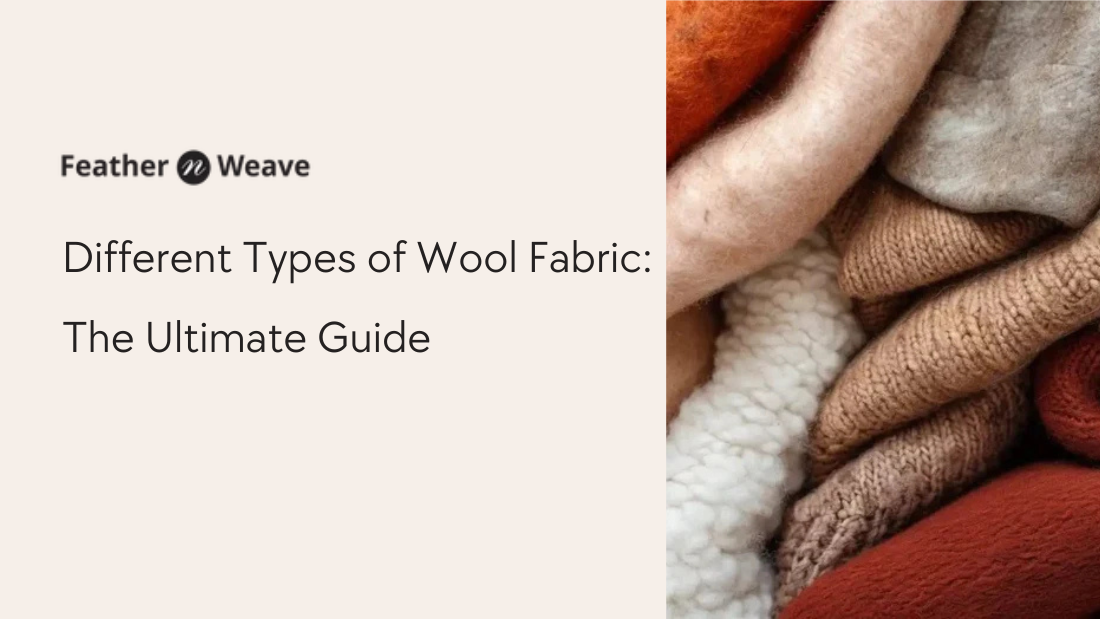
Different Types of Wool Fabric: The Ultimate Guide
Share
Wool, a timeless and versatile fiber, has been cherished for centuries for its warmth, durability, and luxurious feel. From cozy sweaters to elegant suits, wool fabrics come in a myriad of forms, each with unique characteristics and best uses. Understanding these differences can help you make informed choices for your home and personal style.
Let's dive into the fascinating world of wool and explore its most popular types.
Sheep's Wool: The Foundation
When we talk about "wool," we're most often referring to sheep's wool. The properties of sheep's wool vary greatly depending on the breed of sheep, their diet, and the climate they live in.
- Merino Wool: Often considered the "king" of sheep's wool, Merino is renowned for its incredibly fine fibers, making it exceptionally soft, lightweight, and itch-free. It's excellent at regulating temperature, keeping you warm in the cold and cool in the heat, and is naturally odor-resistant.
Best for: Base layers, activewear, fine sweaters, suiting, baby clothing, lightweight scarves.
- Lambswool: This is the first shearing from a lamb, typically when it's around seven months old. Lambswool is very soft, smooth, and hypoallergenic, making it a gentle option.
Best for: Baby blankets, soft scarves, delicate sweaters.
- Shetland Wool: Hailing from the Shetland Islands of Scotland, this wool is known for its durability, warmth, and slightly coarse texture. It's often used for traditional knitwear.
Best for: Durable sweaters, outdoor wear, tweed jackets, winter scarves.
- Donegal Tweed: While not a type of wool itself, Donegal tweed is a famous fabric made from wool (often Cheviot or Merino blends) characterized by its distinctive flecks of colored neps woven into the yarn, creating a rustic, textured look.
Best for: Sport coats, suits, outerwear, textured scarves.
- Harris Tweed: Another iconic tweed, Harris Tweed is legally defined as tweed handwoven by islanders at their homes in the Outer Hebrides of Scotland, using virgin wool dyed and spun in the Outer Hebrides. It's known for its robust nature and rich heritage.
Best for: High-quality suits, blazers, coats, upholstery, and durable scarves.
Alpaca Wool: Luxurious and Lightweight
Alpaca wool comes from alpacas, native to South America. It's known for being incredibly soft, lightweight, and remarkably warm, often warmer than sheep's wool despite its lighter weight. Alpaca fibers are also naturally hypoallergenic as they lack lanolin, a common allergen found in sheep's wool.
- Baby Alpaca: The softest and finest alpaca wool, harvested from the first shearing of an alpaca.
Best for: Luxurious scarves, throws, high-end sweaters, baby alpaca scarves.
- Suri Alpaca: One of the two main breeds of alpaca (the other being Huacaya). Suri alpaca has long, lustrous, dreadlock-like fibers that create a silky, flowing fabric.
Best for: Specialty outerwear, elegant accessories, and elegant scarves
Cashmere: The Epitome of Softness
Cashmere is perhaps the most famous luxury wool, derived from the soft undercoat of cashmere goats. It's incredibly fine, soft, lightweight, and provides exceptional insulation without bulk. Its delicate nature often means it's blended with other fibers for added durability.
Best for: High-end sweaters, cashmere scarves, shawls, loungewear, suiting, luxury scarves.
Mohair: Lustrous and Durable
Mohair comes from the Angora goat (not to be confused with Angora rabbit!). It's known for its distinctive luster, resilience, and warmth. Mohair fibers are strong and durable, making them resistant to creasing and pilling. It often has a slight halo or fluffiness.
Best for: Sweaters, blazers, upholstery, blankets, evening wear, stylish scarves.
Angora: Silky and Fine
Angora wool is harvested from the Angora rabbit. It's incredibly soft, fluffy, and has a distinctive "halo" effect. While very warm, it's also delicate and often blended with other fibers to improve durability.
Best for: Delicate sweaters, angora scarves, baby clothing (often in blends).
Llama Wool: Rustic and Strong
Llama wool, similar to alpaca but generally coarser, offers good warmth and durability. It's often used for more rustic or utility-focused items.
Best for: Rugs, blankets, outer garments, rustic scarves.
Camel Hair: Warm and Elegant
Camel hair wool is typically sourced from the Bactrian camel's soft undercoat. It's known for its natural golden-brown color, lightweight warmth, and soft, fine texture. It's often used in sophisticated outerwear.
Best for: Overcoats, blazers, luxury blankets, camel hair scarves, elegant scarf.
Vicuña: The Rarest and Most Expensive
Vicuña wool is the most luxurious and expensive wool in the world, coming from the vicuña, a wild camelid native to the Andes. Its fibers are incredibly fine, soft, and provide unparalleled warmth. Due to its rarity and ethical sourcing regulations, it's highly prized.
Best for: Exquisite, high-end garments (e.g., vicuña scarves, coats, throws), luxury scarf.
Caring for Your Wool Fabrics
While each type of wool has its unique characteristics, some general care tips apply:
- Hand wash or dry clean: Most woolens prefer gentle hand washing with a mild detergent or professional dry cleaning.
- Avoid hot water and harsh agitation: These can cause shrinkage and felting.
- Lay flat to dry: Reshape your garment and lay it flat on a clean towel to air dry, away from direct sunlight or heat.
- Store properly: Fold knitted woolens to prevent stretching. Use cedar blocks or lavender to deter moths.
Final Thought
From the rugged durability of Shetland to the unparalleled softness of cashmere and vicuña, wool offers a spectrum of textures, weights, and luxurious qualities. Its natural breathability, warmth, and resistance to odor make it a sustainable and practical choice for countless applications. Understanding these different types allows you to appreciate the artistry and natural beauty of this remarkable fiber, helping you choose the perfect wool fabric for your needs and enjoy its enduring appeal for years to come.




